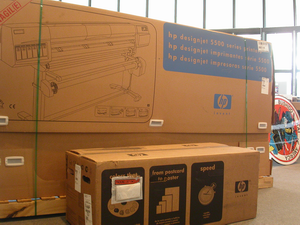HP DesignJet 2800CP and 3800CP.
 |
| HP 5500 wide format printer arriving to FLAAR BGSU facilities. |
How much dpi (in your print) does your 600 dpi printer really want, or need? These crucial tidbits of information never seem to be in the instruction or operating manual.
John Nagel, Director of the Center for Advanced Imaging (St Louis,MO) said that 120 dpi was more than enough for his HP 2500 and 3500. He said that a normal viewer did not notice any improvement in quality if you used a higher dpi. Nagel exhibits his Hewlett-Packard prints at 120 dpi (image dpi; the printing dpi is 600 dpi from the printer).
Yet I am always curious how much dpi you can feed a printer before it gets indigestion. With the Encad NovaJetPro, files over 180 dpi began to give the system indigestion. This is not really a fault of Encad, it is more likely a restriction of PostScript. Anyway, "indigestion" means that the RIP selects about 33% of the image, eliminates the other 66% and then stretches the selected 33% and fills the entire space with this stretched (and hence distorted) image. With the HP when I raised the dpi to over 275 I reached the point where the system could no longer handle it.
Hewlett-Packard itself told us that 150 dpi in your TIF file was plenty of dpi to achieve 600 dpi output.
After several more tests it turns out that 225 MB is about as much as the printer really can take (and this much is probably more than enough). Yes, you can squeeze 226 or more MB through the system, but over 237 MB the system gets indigestion (since the system does not need or want that much). This is not a defect it is just that dpi in your image is not the same as pixels vs dots per inch in the actual print. Get any good book on digital imaging and find out the technical background of this (check out books by Agfa, Graphic Arts Technical Foundation, etc, see indices to all FLAAR sites especially www.digital-photography.org, www.cameras-scanners-flaar.org for "book reviews").
Now that you know you need only between 120 and 150 dpi in your original TIF file you can RIP more quickly. Try JPEGing your files to see how that affects RIP time (be sure to JPEG at maximum quality setting, and do this only to a copy of your TIF file). If you JPEG your original file you can never recover its original condition. In theory, the Hewlett-Packard DesignJet printer is capable of producing full quality on a JPEGed image, but be sure to test this yourself. We have not yet JPEGed our files.
If you are seeking a used HP DesignJet printer. How do you know whether the printer even works? So if you need reassurance that your used printer is reconditioned, consider checking with [email protected] or [email protected]. They are HPauthorized dealers.
If you seek info on Wasatch SoftRIP for an HP or Encad (thermal printers), contact Jonathan Knecht, tel toll free 888 BIG-COLR, e-mail [email protected].
We only recommend resources that offer competent technical support, experience based on years in the business, and a company where we have personally met (and checked out) the people behind the name. Thus if you are considering acquiring any HP DesignJet printer, you can contact Jonathan Knecht with confidence, e-mail [email protected] , toll free (888) 244-2657.If you are in Canada or outside USA, please contact your local national dealer. Most USA resellers do not sell outside the continental USA.
Most recently updated March 11, 2005.
Previous updates: July 05, 2001.